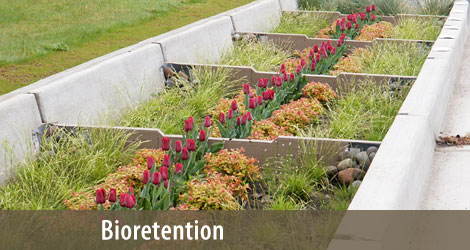Bioretention
Swales, cells and planters
Bioretention uses an engineered, shallow depression with a specific soil mix and plants adapted to the local climate to collect surface runoff from a specific area. Soil elements such as microbes, organic materials and minerals and plants transform, retain or remove pollutants, which allows cleaner water to infiltrate into the ground or discharge to section of a treatment train. The systems can vary in shape and style, including above-ground planters, swales or cells integrated into the site’s stormwater management plan. They can use small retaining elements, such as curbs, weirs or small walls, to direct water into the facility. In many cases, an underdrain will help disperse the filtered water.
Featured sites
1. Mt. Vista Neighborhood
Between NE 33rd & 36th avenues & NE 160th & 163rd streets, Vancouver
In summer 2012, Clark County constructed numerous curbside bioretention planters in the Mt. Vista neighborhood to improve treatment of polluted storm runoff and better protect nearby Mill Creek. This project helps improve water quality and fish habitat in Mill Creek which, although degraded, continues to support threatened salmon and steelhead.
Bioretention planters – Seventeen planters drain most of the 50-acre neighborhood. The $535,000 project extended curbs and added piping infrastructure, drain rock and plantings. Water infiltrates through amended soils, and overflow can discharge to the storm sewer system. Maintenance depends on plant survival and the amounts of accumulated sediment, oil, grease and metal pollutants. Cleaning is done at the end of the rainy season and after the first storm at the beginning of the rainy season. Maintenance cost is anticipated at approximately $2,000 per year.
Native plantings – Bioretention planters contain plants that can adapt to the fluctuating water levels of various storms. Many species are native to this region and can handle the dry summer season.
Watch how the low impact development of a rain gardens retrofit has worked in the Mount Vista subdivision, Clark County Washington.
2. Northeast 99th Street Bioretention Planters
NE 99th Street between NE 118th & 126th avenues
In 2010, Clark County created several bioretention planters along both sides of Northeast 99th Street to capture rain water from the road surface. Each planter has curb openings to allow water to flow into it. Each is planted with a variety of native plants or trees. The adjacent sidewalk includes sections of pervious concrete. The entire project cost $6.17 million. Stormwater elements cost approximately $900,000.
Bioretention – The 2,833-foot-long planters collect water from approximately 4.5 acres of roadway and sidewalk. The soils here are good for infiltration – three inches of rain percolates in 24 hours – so most water entering the planters will infiltrate to the ground. Overflow piping is included for any significant flooding. The smallest planter can handle a two-year storm – two inches of rain percolating in 24 hours. The bioretention planters treat runoff in accordance with Department of Ecology standard of 91 percent filtration of the annual rainfall volume. Maintenance is done once or twice a year based on the planters’ condition.
Pervious concrete – A porous sidewalk needs less maintenance, but frequency is dependent on usage. Eventually, pressure washing is needed.
Learn how rain gardens and pervious concrete work in the low impact development 99th Street road improvements, Clark County Washington.
Luke Jensen Sports Park
4000 NE 78th St., Vancouver
This 18-acre park was developed in 2011-2012 to provide soccer and baseball fields in the Hazel Dell area. The site includes retained native trees, synthetic sports fields that allow infiltration, a concession/restroom building, playground, parking, stormwater features and pathways. A natural area was preserved. Project cost was $8.2 million.
Bioretention swales and planters – The parking area includes two bioretention swales and a bioretention planter that capture water from the one-acre parking lot. The swales and retention planter have curb cuts to allow water to enter the systems, where it flows through native plantings prior to infiltrating the amended soils. The synthetic sports fields also include drain rock that allows for more than 50,000 cubic feet of detention and infiltration under the fields.
Native plantings – The bioretention features, landscape beds and stormwater pond include native plantings that increase the site aesthetics, provide wildlife habitat and require less on-going maintenance.
See how rain gardens and synthetic turf work in the low impact development Luke Jensen Sports Park, Clark County Washington.
LID Techniques
